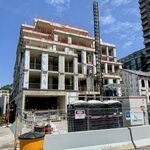steveintoronto
Superstar
I was watching some vids of the 'procession', http://www.cbc.ca/news/canada/toronto/bloor-bike-lanes-1.3718197 It was *very* orderly, if not sedate, many children in carriers on bikes. In other words, it was the 'ideal' of circumstances for everything to go right. Plus with all the cameras on them, and the many cops and officials present, anyone prone to misbehave would have been caught for all to see.Yes the pics were taken around that time, after the press conference. Traffic volumes were reduced since most commuters arrived to work by then, and most shops still haven't opened for business. I plan to revisit Bloor next week during the afternoon to see how it performs under more challenging conditions.
That had occurred to me, but as a trade-off for over-all safety, that's got to be the cost. It's ironic you mention that, as Metro Police issued a warning today that they will be out in force ticketing at Queen's Quay, pedestrians, cyclists and drivers. Don't have link handy, (edit to add:For a pilot project, implementing a bi-directional lane would require new traffic signals which would significantly increase the cost (not that I'm against that, but unfortunately I don't have a vote at city hall). You might be right that it's the best solution for the narrow sections of Bloor, but then it would also have to be implemented along the rest of Bloor and Danforth which for the most part are significantly wider. Otherwise cyclists will have to cross the street whenever the lane changes from uni-directional to bi-directional.
Queens Quay crackdown this weekend reminds us of the rules
Redesigned street is popular but ‘you really have to keep your wits about you,’ admits mayor.)
https://www.thestar.com/news/gta/20...own-this-weekend-reminds-us-of-the-rules.html
but there was a news story or two on it. It is a problematic location, and confusing for many, but Montreal makes a much better comparison with that bi-directional pic I reposted from another poster five years back. Your pics are excellent in catching a lot of the dynamics in discussion, they help immensely in portraying proximity of passenger doors to passing bikes.
It's a very real point! There'll never be a risk free way of doing this, bikes barely mix with bikes, let alone with motorized vehicles, but the present Bloor design if fraught with dangers. People getting hurt is one thing, but as ADRM has made clear, it's far more than that, it's using a *very poor design* to hinge the implementation or not of further bike lanes. If that is the case, then they'd damn well best base it on a rational model. This certainly isn't as is. I think they're going to have to re-visit this much sooner than the "2017" touted.As for motorists, my experience with using the bi-directional Eglinton West trail is that some drivers are not looking properly before they make a turn at an intersection. Someone who's turning left will always check for oncoming traffic but some forget that cyclists can come from the opposite direction.
The bi-directional route with parking the other side of the street would offer far more benefits than detriments though. The only time any pedestrian or vehicle passenger would be in the bike lanes would be to cross the road, and you can't make it totally idiot-proof, but anyone doing that would have a much greater chance of looking and being aware....one would hope!
Every time I look at your pics (some angles are perfect to show these nuances) and then at that Montreal bi-directional one, I see vastly better utilization of road width, let alone safety and inherent flow through-put with the latter.
but then (bi-directional cycle lane) would also have to be implemented along the rest of Bloor and Danforth which for the most part are significantly wider.
I digress! There's absolutely no reason to not use separate east/west lanes *where space permits!* Done right, it's the best way to go. One of the problems of the bi lane is oncoming cyclists unable to judge speed and trajectory, or just plain ignorance, and taking your lane oncoming. It happens all the time on the Lakeshore Trail especially. However, given the choice of dealing with getting doored, or a head-on with a vehicle v. another bike, I'll go for the latter. I think most of us would.
lol..it's the old "would you prefer to be cut by a rusty serrated knife or a broken razor-blade" question.
I'll see if there's any studies on 'best practice' for bike-lanes bi v separated. Toronto actually is one of the Cdn leaders in bike lane studies, I used to quote them extensively when living in Guelph, so many misconceptions were rampant. Nothing like a study from "the big city" to placate little city minds. Sometimes...
Last edited:










